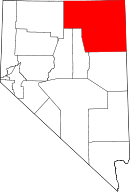Metropolis, Nevada
| Metropolis, Nevada | |
|---|---|
| Ghost town | |
|
Ruins of the Lincoln School in Metropolis | |
 Metropolis  Metropolis Location within the state of Nevada | |
| Coordinates: 41°13′41″N 115°3′22″W / 41.22806°N 115.05611°WCoordinates: 41°13′41″N 115°3′22″W / 41.22806°N 115.05611°W | |
| Country | United States |
| State | Nevada |
| County | Elko |
| Time zone | Pacific (PST) (UTC-8) |
| • Summer (DST) | PDT (UTC-7) |
Metropolis, Nevada is a ghost town in Elko County, Nevada, 12 mi (19 km) northwest of Wells.
During the early twentieth century, many homesteaders attempted to farm in the Great Basin, especially in western Utah but also in northeastern Nevada.[1] Creating the town of Metropolis was the project of an eastern businessman, Harry[2] L. Pierce of Leominster, Massachusetts, and investors from both Massachusetts and Salt Lake City.[3] During the second decade of the twentieth century, Pierce's Pacific Reclamation Company intended to make the optimistically named Metropolis the center of a huge farming district.[4]
The Company purchased 40,000 acres (16,000 ha) of desert land in 1910 and hired a respected Salt Lake City contractor, P. J. “Pat” Moran, to build a dam on Bishop Creek, 15 mi (24 km) east of the planned city, hoping to use the reservoir for irrigation.[5] Once the dam was complete, the Company stepped up its promotional campaign, and the LDS Church encouraged members to move there. The town became predominately Mormon, and no church was ever built in Metropolis because the Mormons used the town amusement hall as a meetinghouse.[6]
In an attempt to demonstrate permanence, the Company built the amusement hall, a post office, a school, a train depot, and a magnificent modern hotel, complete with an electric generator, central heating, and hot and cold running water in every room. A railroad spur was extended to the town site, and regular passenger service began in 1912. The population grew to nearly 700.[7]
Superficially the town seemed a success, but it faced serious problems. Pierce had failed to obtain water rights to Bishop Creek, and the downstream town of Lovelock sued to prevent the impoundment of water behind Bishop Creek Dam. Because residents could not irrigate, many tried dry-farming wheat, successfully at first.[8]
After settlers killed marauding coyotes, the jackrabbit population rose dramatically. Rabbits systematically ate the wheat, and farmers retaliated with guns, poison, and organized drives. They killed thousands of jackrabbits and sold them in San Francisco.[9]
Dry-farming had been possible for a few years only because of unusually high precipitation. Lower rainfall and Mormon crickets ended the experiment. Pacific Reclamation declared bankruptcy in 1920. In 1922 the railroad discontinued service. By 1924, only 200 people remained. The amusement hall and hotel burned, and the last store closed in 1925, the post office in 1942.[10] The few remaining residents turned to ranching. By 1950 Metropolis was a ghost town. Today ranches surround the town site. The ruins of the hotel and school and a cemetery are all that remain.[11]
References
- ↑ Matt C. Bischoff, California and Nevada Hot Springs, 2nd ed. (Globe Pequot, 2005), 201.
- ↑ Usually Pierce's first name is incorrectly given as "Harvey."
- ↑ Richard A. Fifer, “Harry L. Pierce, the ‘Phosphate King," unpublished paper, Leominster Historical Society.
- ↑ Shawn Hall, Old Heart of Nevada: Ghost Towns and Mining Camps of Elko County (University of Nevada Press, 1998), 118.
- ↑ John P. Young, Journalism in California (San Francisco: Chronicle Publishing Company, 1915), 301.
- ↑ Hall, 120. A noted Mormon agricultural scientist, John A. Widtsoe, had already issued a number of bulletins about dry-land farming, and in 1911, he published Dry Farming: A System of Agriculture for Countries under a Low Rainfall (New York: Macmillan, 1911). Leonard J. Arrington and Davis Bitton, The Mormon Experience: A History of the Latter-day Saints (Urbana: University of Illinois Press, 1979), 310-13.
- ↑ Claudia Wines, “Metropolis: The Glory Days,” Northeastern Nevada Historical Society Quarterly, (2008): 76.
- ↑ Wines, 76.
- ↑ Wines, 77-78.
- ↑ Hall, 122.
- ↑ In 1989, former residents erected a monument “in memory of those valiant pioneers who settled and built a city here.”
Further reading
- Shawn Hall, Old Heart of Nevada: Ghost Towns and Mining Camps of Elko County (University of Nevada Press, 1998), 118-123.
- Heidi Knapp Rinella, Nevada: Off the Beaten Path (Globe Pequot, 2007), 109-11.
- Claudia Wines, "Metropolis: The Glory Days," Northeastern Nevada Historical Society Quarterly (2008), 70-80.
- John P. Young, Journalism in California (San Francisco: Chronicle Publishing Company, 1915), 301. Biographical sketch of P. J. Moran.
External links
| Wikimedia Commons has media related to Metropolis, Nevada. |
- Metropolis, historic and contemporary photos.
- Bishop Creek Dam, description and photos.
